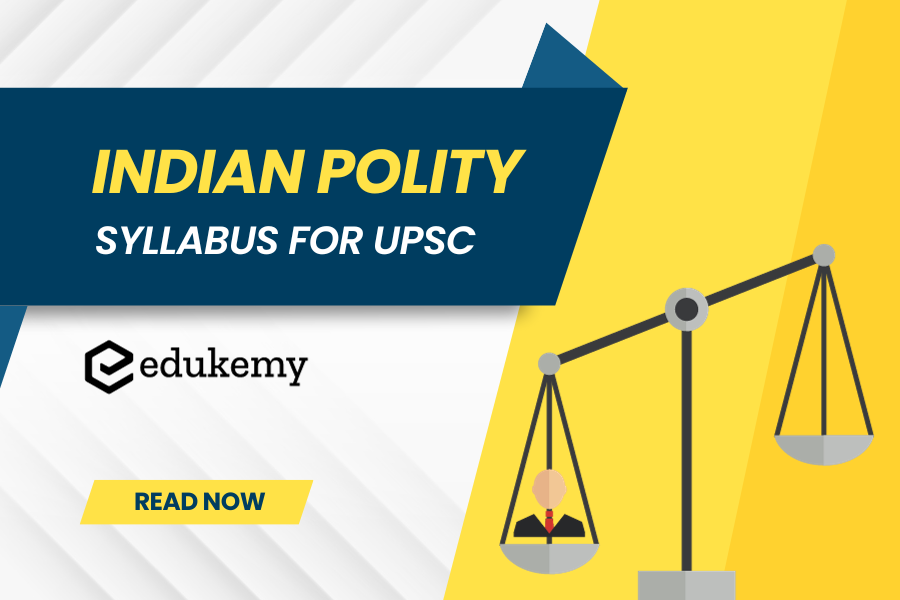The syllabus of Indian Polity covered in the UPSC exam is a significant and essential part of the preparation. It focuses on the political scenario and administrative mechanisms that govern the structure of India. The focussed areas of knowledge encompassing this syllabus include the evaluation of the Indian Constitution, the institutions and processes of the Indian political system, and the workings of the Government of India.

Contents
Indian Polity Syllabus for UPSC IAS Exam
The UPSC IAS Exam (Union Public Service Commission – Indian Administrative Service Exam) is a highly competitive examination that assesses candidates’ knowledge and understanding of various subjects, including Indian Polity. The Indian Polity syllabus for the UPSC IAS Exam is comprehensive and covers a wide range of topics. Here are the key points in the Indian Polity syllabus for UPSC:
- Historical Background:
- Evolution of the Indian Constitution.
- Making of the Constitution – Constituent Assembly and its committees.
- Preamble of the Constitution:
- Significance and components.
- Union and its Territory:
- Article 1-4: Name and territory of the Union.
- Changes in the territory of India through constitutional amendments.
- Citizenship:
- Modes of acquiring citizenship.
- Citizenship-related provisions in the Constitution.
- Fundamental Rights (FRs):
- Nature and significance.
- FRs enshrined in the Constitution.
- Judicial review and the role of the Supreme Court in protecting FRs.
- Writs and their significance.
- Directive Principles of State Policy (DPSP):
- Nature and importance.
- Relationship between Fundamental Rights and Directive Principles.
- Critique and challenges in their implementation.
- Fundamental Duties:
- Added by the 42nd Amendment.
- Significance and criticisms.
- Amendment of the Constitution:
- Procedure and provisions under Article 368.
- Important amendments and their implications.
- Basic Structure Doctrine:
- Judicial interpretation by the Supreme Court.
- Key cases defining the basic structure.
- Union Executive:
- President, Vice-President, Prime Minister, Council of Ministers, Attorney General.
- Powers and functions.
- Emergency provisions under Article 352-360.
- Parliament of India:
- Structure and composition.
- Lok Sabha, Rajya Sabha, and their functions.
- Parliamentary committees.
- State Executive:
- Governor, Chief Minister, Council of Ministers.
- State Legislature and its powers.
- Local Government:
- Panchayati Raj Institutions (PRIs) and Urban Local Bodies (ULBs).
- 73rd and 74th Constitutional Amendments.
- Judiciary:
- Structure of the judiciary.
- Independence of the judiciary.
- Judicial review and PIL (Public Interest Litigation).
- Elections:
- Election Commission.
- Conduct of elections and electoral reforms.
- Anti-defection Law:
- Tenth Schedule of the Constitution.
- Special Provisions for SCs, STs, OBCs, and Minorities:
- Constitutional provisions and government initiatives.
- Tribunals:
- Administrative Tribunals, National Green Tribunal, etc.
- Constitutional and Statutory Bodies:
- Important bodies like UPSC, SPSC, CAG, NHRC, etc.
- Public Policy and Governance:
- Government policies and their impact.
- Good governance and e-governance initiatives.
- Challenges to the Indian Polity:
- Federalism issues, center-state relations.
- Regionalism, communalism, and caste politics.
Candidates preparing for the UPSC IAS Exam should refer to the official UPSC syllabus for the most accurate and updated information. Additionally, it is crucial to stay informed about current affairs and the latest developments in Indian polity and governance.
FAQs on Indian Polity Syllabus
Q1: How is the Indian Parliament constituted?
A1: The Indian Parliament consists of two houses: The lower house the Lok Sabha also known as the House of the People and the upper house, the Rajya Sabha also known as the Council of States. While the Lok Sabha is directly elected by the people of India the Rajya Sabha is elected by the members of the State Legislative Assemblies. The President of India is also one of the important components of the Parliament.
Q2: In what way does the Directive Principles of State Policy in the constitution of India play its role?
A2: DPSP stands for The Directive Principles of State Policy which are guidelines and principles given in Part IV of the Indian Constitution. Though they are not legally binding and cannot be compelled in any court of law they are crucial in the management of the nation. These principles compel the state to foster social and economic justice; protect the environment; encourage equality and; the progressive human well-being of its citizens.
Q3: How are Chief Ministers of Indian states elected?
A3: The Governor of the respective state in India appoints the Chief Minister of a state in India. In most cases, after an election, the person who leads the majority party in the State Legislative Assembly is a being called by the Governor to form the government and become the Chief Minister. Originally, the person chosen as the Chief Minister was that candidate who enjoyed the majority in the assembly, but in case of a hung assembly or a coalition government, the Governor enjoys discretionary powers when appointing the head of the Government.
Q4: What are the functions of Election Commission of India?
A4: The Election Commission of India ECI is an independent body that is a constitutional body of India working for the supervision to conduct elections in India. These are the main responsibilities: organization of free and fair elections of the Parliament, State Legislatures as well as the President and Vice President of the country. The ECI also implements the Model Code of Conduct for elections to check any unfair means during the campaign.
To get free counseling/support on UPSC preparation from expert mentors please call 9773890604
- Join our Main Telegram Channel and access PYQs, Current Affairs and UPSC Guidance for free – Edukemy for IAS
- Learn Economy for free- Economy for UPSC
- Learn CSAT – CSAT for UPSC
- Mains Answer Writing Practice-Mains Answer Writing
- For UPSC Prelims Resources, Click here

